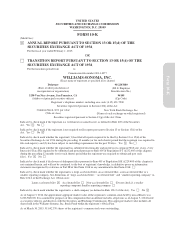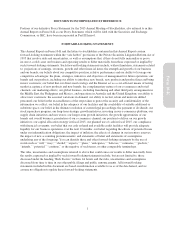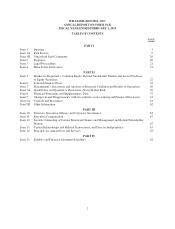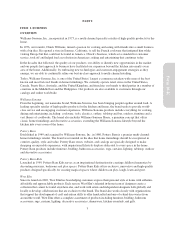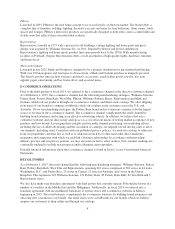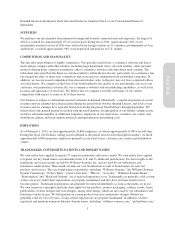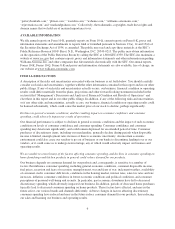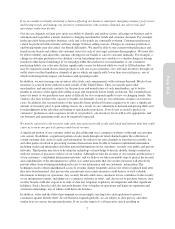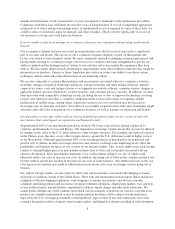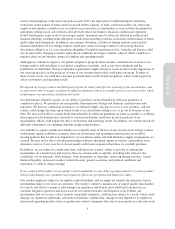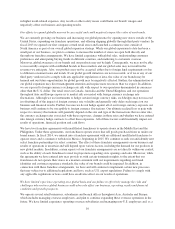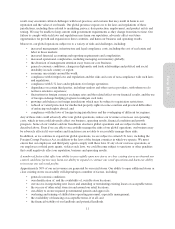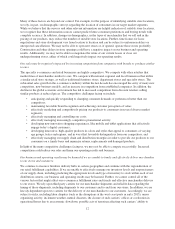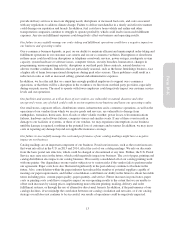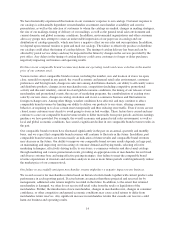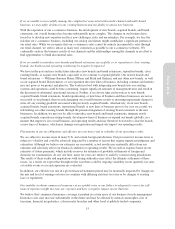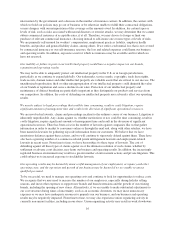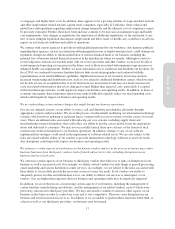Pottery Barn 2014 Annual Report Download - page 21
Download and view the complete annual report
Please find page 21 of the 2014 Pottery Barn annual report below. You can navigate through the pages in the report by either clicking on the pages listed below, or by using the keyword search tool below to find specific information within the annual report.
If we are unable to identify and analyze factors affecting our business, anticipate changing consumer preferences
and buying trends, and manage our inventory commensurate with customer demand, our sales levels and
operating results may decline.
Our success depends, in large part, upon our ability to identify and analyze factors affecting our business and to
anticipate and respond in a timely manner to changing merchandise trends and customer demands. For example,
in the specialty home products business, style and color trends are constantly evolving. Consumer preferences
cannot be predicted with certainty and may change between selling seasons. Changes in customer preferences
and buying trends may also affect our brands differently. We must be able to stay current with preferences and
trends in our brands and address the customer tastes for each of our target customer demographics. We must also
be able to identify and adjust the customer offerings in our brands to cater to customer demands. For example, a
change in customer preferences for children’s room furnishings may not correlate to a similar change in buying
trends for other home furnishings. If we misjudge either the market for our merchandise or our customers’
purchasing habits, our sales may decline significantly or may be delayed while we work to fill backorders. We
may be required to mark down certain products to sell any excess inventory or to sell such inventory through our
outlet stores or other liquidation channels at prices which are significantly lower than our retail prices, any of
which would negatively impact our business and operating results.
In addition, we must manage our inventory effectively and commensurate with customer demand. Much of our
inventory is sourced from vendors located outside of the United States. Thus, we usually must order
merchandise, and enter into contracts for the purchase and manufacture of such merchandise, up to twelve
months in advance of the applicable selling season and frequently before trends are known. The extended lead
times for many of our purchases may make it difficult for us to respond rapidly to new or changing trends. Our
vendors also may not have the capacity to handle our demands or may go out of business in times of economic
crisis. In addition, the seasonal nature of the specialty home products business requires us to carry a significant
amount of inventory prior to peak selling season. As a result, we are vulnerable to demand and pricing shifts and
to misjudgments in the selection and timing of merchandise purchases. If we do not accurately predict our
customers’ preferences and acceptance levels of our products, our inventory levels will not be appropriate, and
our business and operating results may be negatively impacted.
We may be exposed to cybersecurity risks and costs associated with credit card fraud and identity theft that could
cause us to incur unexpected expenses and loss of revenue.
A significant portion of our customer orders are placed through our e-commerce websites or through our customer
care centers. In addition, a significant portion of sales made through our retail channel require the collection of
certain customer data, such as credit card information. In order for our sales channels to function successfully, we
and other parties involved in processing customer transactions must be able to transmit confidential information,
including credit card information and other personal information on our customers, securely over public and private
networks. Third parties may have or develop the technology or knowledge to breach, disable, disrupt or interfere
with our systems or processes or those of our vendors. Although we take the security of our systems and the privacy
of our customers’ confidential information seriously, and we believe we take reasonable steps to protect the security
and confidentiality of the information we collect, we cannot guarantee that our security measures will effectively
prevent others from obtaining unauthorized access to our information and our customers’ information. The
techniques used to obtain unauthorized access to systems change frequently and are not often recognized until after
they have been launched. Any person who circumvents our security measures could destroy or steal valuable
information or disrupt our operations. Any security breach could cause consumers to lose confidence in the security
of our information systems, including our e-commerce websites or stores, and choose not to purchase from us. Any
security breach could also expose us to risks of data loss, litigation, regulatory investigations and other significant
liabilities. Such a breach could also seriously disrupt, slow or hinder our operations and harm our reputation and
customer relationships, any of which could harm our business.
In addition, states and the federal government are increasingly enacting laws and regulations to protect
consumers against identity theft. As our business expands globally, we are subject to data privacy and other
similar laws in various foreign jurisdictions. If we are the target of a cybersecurity attack resulting in
7
Form 10-K




